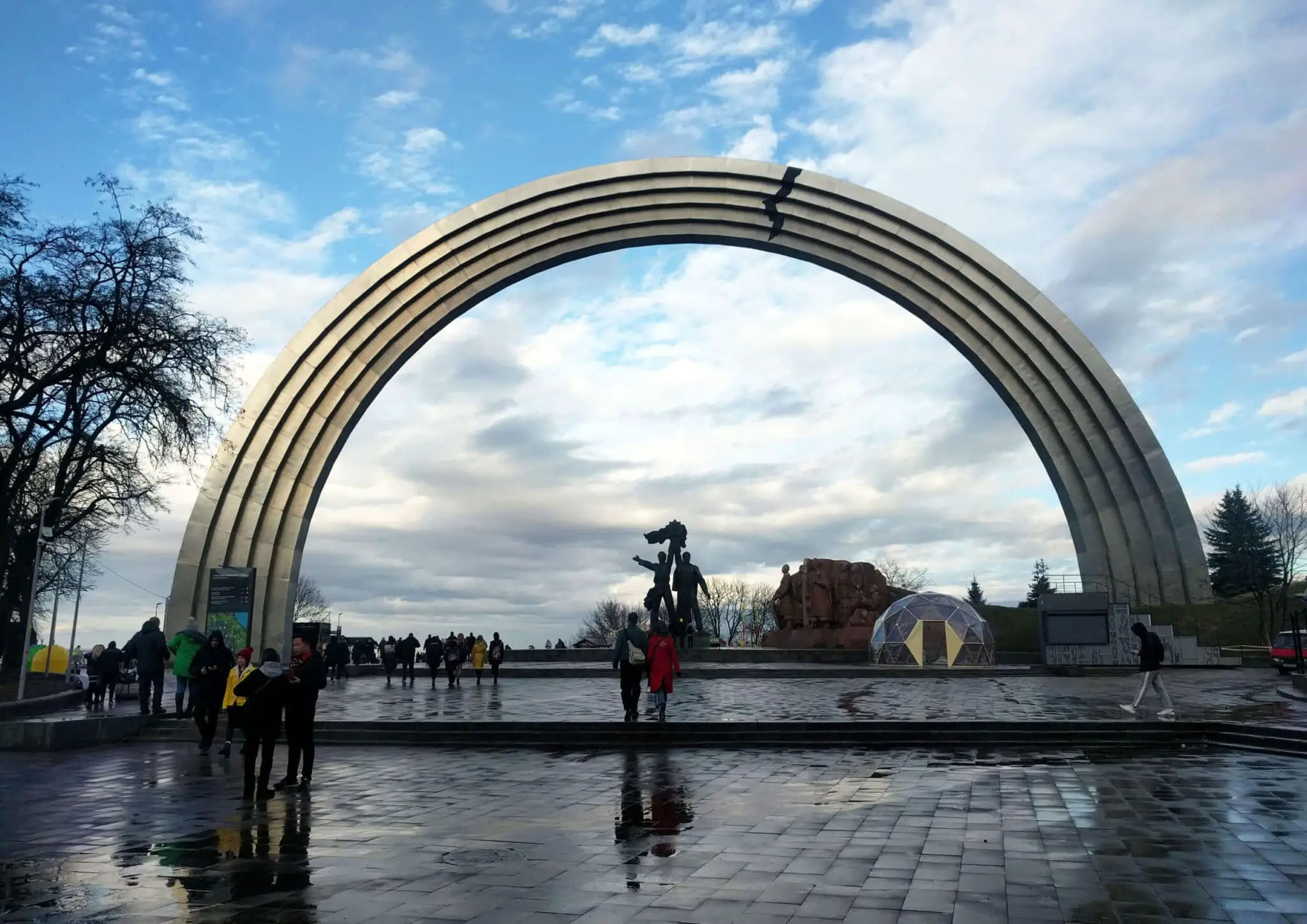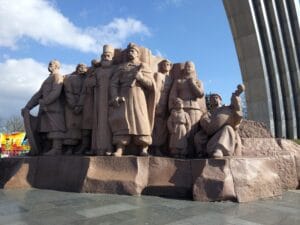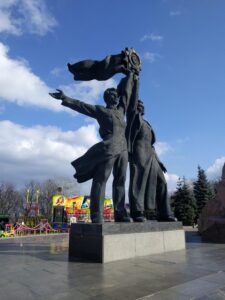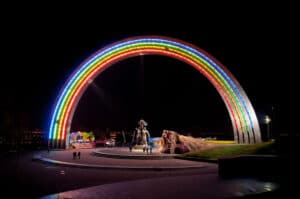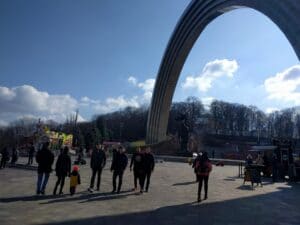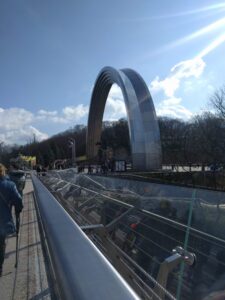The People’s Friendship Arch is one of Kyiv’s most iconic and controversial landmarks. The rainbow-shaped arch perches on a hill overlooking the Dnieper River and large parts of Kyiv. “Gifted” to Ukrainian SSR by the Soviet government in Moscow, it remains heavily associated with the USSR, and although it remains a tourist destination and local hangout, some Ukrainians argue that a massive, celebratory symbol of what they see as a former occupying force should have no place in the modern city. Further, its association with Moscow and depiction of a Ukrainian and Russian man marching together in stride is further complicated by Russia’s recent annexation of Crimea and support for the separatist movements in Donbass.
People’s Friendship Arch: History and Controversy
The People’s Friendship Arch opened in 1982. That date coincided with three important dates in Ukrainian and Soviet history: the 60th anniversary of the USSR, the 65th anniversary of the October Revolution, and the 1500th anniversary of Kyiv’s founding. The complex opened with much fanfare with the First Secretary of the Central Committee of the Communist Party of Ukraine Volodymyr Shcherbytskyi directing ceremonies.
The monumental complex comprises a massive titanium arch fifty meters in diameter as well as the bronze statue of the two men and a granite stele (standing stone slab). There is amphitheater seating built into the hillside facing the arch and an observation deck behind it that overlooks the city. In 2019, a massive pedestrian bridge linking the complex to the nearby Saint Volodymyr Hill Park Complex was completed.
The bronze statue depicts Ukrainian and Russian workers holding hands, together lofting the Soviet Order of Friendship of Peoples. This order was awarded to people, organizations, military units, and divisions of the USSR responsible for “strengthening inter-ethnic and international friendship and cooperation.” The granite stele features a relief of Ukrainian leader Bogdan Khmelnytsky and Russian ambassador Vasyl Buturlin at the Pereyaslav Council of 1654. In Russian historiography, the Pereyaslav Council is regarded triumphantly as marking the unification of Ukraine with Russia. Some Ukrainians, however, view the event more morosely as the moment when Ukraine lost its independence.
The controversy has manifested in popular nicknames for the People’s Friendship Arch, which humorously refer to the rounded shape as “The Bagel” or “Monument to the Cyclist” – both of which would seem to refer to it as broken, as the arch is an incomplete circle. Nationalists sometimes refer to it as “The Yoke,” directly associating it with repression and occupation, similarly to the “Mongol Yoke,” the name often used in Russian historiography for that period in which Russia was part of the Mongol Empire.
Protests Against the People’s Friendship Arch
There have been official protests against the monument as well. A proposal was floated to remove the statues and leave only the Friendship Arch, which would be renamed “The Arch of the Cathedral,” essentially uniting it with the St. Volodymyr’s Cathedral complex on the neighboring hill. In May 2016, Ukrainian Minister of Culture Yevhen Nyschuk announced plans to dismantle the entire complex as part of Ukraine’s ongoing official policy of decommunization. He planned to replace it with a memorial to the veterans of the war in Donbas. Ultimately, reticence to enact change, lack of funding for a new memorial, and concern with removal’s impact on tourism overrode discontent with the arch complex. For now, at least, People’s Friendship Arch is here to stay, a persistent reminder of Ukraine’s Soviet past and current complicated relationship with Russia.
Activists have also attempted to alter The People’s Friendship Arch complex themselves. Protestors removed the bronze statue’s inscription reading “In commemoration of the unification of Ukraine with Russia” and spray painted “Glory to Ukraine!” with a Ukrainian flag over the still-visible remnants. On Twitter and elsewhere, people imagined additions to the arch signifying the current discord between Ukraine and Russia, one of which included adding silhouettes of rockets traversing the arch.
Other, more official instances of repurposing the site have also been allowed. For instance, during the Eurovision song contest, hosted in Kyiv in 2017, the People’s Friendship Arch was painted in the colors of the rainbow and renamed “The Arch of Diversity.” Officially, the city authorities denied any connection to LGBTQ issues. However, Kyiv Pride organizers adopted the arch as the icon of the 2017 Kyiv Pride festivities and conservative elements of Ukrainian society decried the arch as “propaganda” for sexual orientation minorities and transgender people, sparking international controversy that appeared in numerous global news sources. Within three weeks, the colors were removed, but many were left wondering why it had turned into such an issue in first place, for the arch had long featured multicolored neon lights which, at night, make the arch light up like a rainbow. In fact, a long-standing nickname for the arch, usually used affectionately, is “The Rainbow.” Even after the song contest ended and the arch returned to its historic state, the lights remained.
In 2018, Ukrainian artists and human rights activists painted, apparently with city permission, a large crack near the apex of The People’s Friendship Arch. The crack was added on Holodomor Remembrance Day, a day to remember the great famine of 1932-33, which many in Ukraine claim was an act of genocide against the Ukrainian people. The crack painted was meant to assert that the ties between Ukraine and Russia have long been troubled, rather than friendly, and today’s events in Crimea and Donbass have only been a continuation of that. One of the organizers described the purpose of the crack in a statement:
“The Arch of Friendship of Peoples is a monument to totalitarianism. We dedicate this rift to the problem of war, the seizure of territories, and the problem of (Russia’s) holding Ukrainian political prisoners.”
In 2019, a pedestrian bridge was completed between the park containing the arch and the neighboring hill, containing the St. Volodymyr’s Cathedral complex, another popular tourist attraction and local hangout. The day after it opened, it was closed again for repairs as several of the heavy, clear panels of the bridge had been broken. Although those responsible were never identified, many assumed that this was another act of protest against anything that might be seen as supporting The People’s Friendship Arch.
The People’s Friendship Arch as a Popular Public Space
Despite the controversy, the space around the monument complex remains a popular locale in Ukrainian public life. The UPark Music Festival was held at the arch’s amphitheater in 2018, drawing internationally recognized bands. In the winter of 2019, thirty tons of snow were brought from the Carpathian Mountains to build a five-story snow jump under the arch and a temporary snow park for snowboard competitions. Lively New Year’s celebrations are held here. On any given day, the Friendship Arch complex hosts rides for children and a variety of vendors selling carnival food, tea, and mulled wine. The Friendship Arch View Point features spectacular views of the Dnieper River and historic left-bank Kyiv. This draws tourists and Kyivites alike to the site to take pictures, enjoy the views, and spend time outside in good weather. On Sundays, many people promenade down the pedestrian main street to the arch complex. Skateboarders enjoying the contours of the space are another common sight.
While the Friendship Arch Complex remains a point of contention within Ukrainian society, the continued life, commerce, and construction around the complex is a sign that, for now at least, it remains a lively fixture of Kyivan life, although the debate continues.


